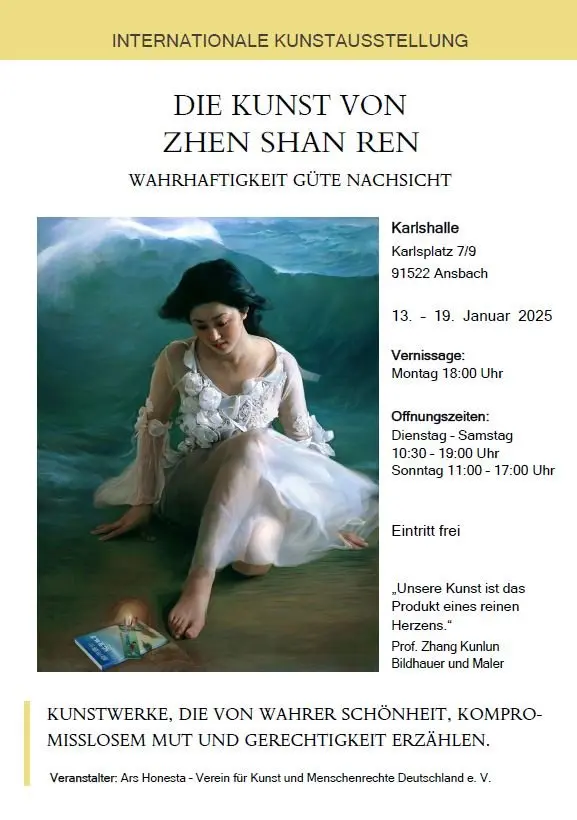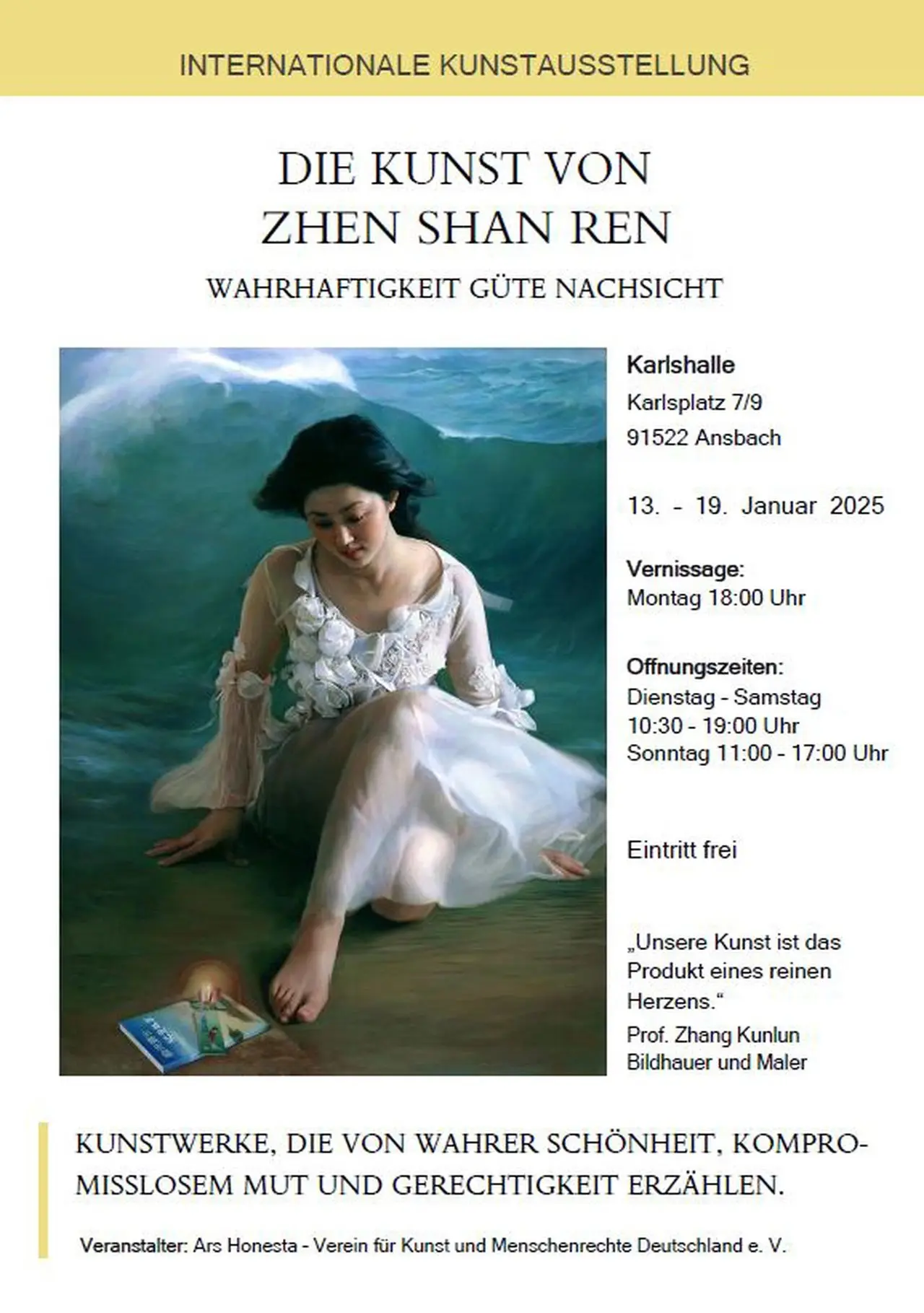From January 13 to 19, 2025, the international art exhibition: “The Art of Zhen Shan Ren” will be held in the Karlshalle in Ansbach (see photo for details). I would like to encourage you all to visit this exhibition. Last year, the paintings were on display in Coburg and I had the honor of giving the opening speech. I would like to use my thoughts and words at that time to stimulate your own thoughts and make you want to visit this impressive exhibition.
Poetry, language - visual language and painting
or
Poetry and visions: Language forms and
Thoughts on completeness
PROLOG
I was asked to talk about how the idea for staging the art exhibition in Coburg came about. The explanation is quite simple: it was a vision. I have been familiar with visions since the beginning of my lyrical work. To clarify the term vision, I would like to present a poem of mine - as an example and expression of one of my visions. This poem was written in 2010, when I was sitting at my desk in Bonn. These lines came to me out of nowhere. Since then, I have written many more poems and lyrical works.
In the space of fog
Man wanders around in this room.
Vision blurred in the fog, everything is difficult for him.
Everyone indulges in lust and greed.
The principles are reversed, all the dirt is here now.
He is searching for peace in his heart.
The bad beings joke about them.
Every step decides whether joy or sorrow.
The old home forgotten, soon the time will come.
The cosmos is changing fast.
Where once there was darkness, it suddenly becomes light.
The sky becomes pure, the new cosmos awakens.
The Creator corrects the cosmos, his work is done.
S. N.
Another vision was this art exhibition. It was born after a visit to Coburg, when I was standing on the market square. Helmut Schmidt once said: “If you have visions, you should see a doctor!” I didn't go to the doctor, however, but contacted the organizer of this exhibition - and the vision became reality. Now we are standing here - not in the room of fog, but in Coburg. I'm not speaking a prologue in heaven, as in Goethe's Faust I, but rather getting us in the mood for the exhibition.
Apropos Faust I: Goethe once said, “Art is a mediator of the inexpressible.” Goethe himself was a great lyricist, a poet of the German spirit, the prince of poets. Now, in the following lines, I would like to share with you a few thoughts of mine about poetry, painting and the connections between them.
SPEECH
I started painting just over 13 years ago. Colors, brushes, canvases - my equipment grew quickly. Watercolor, acrylic, oil, pastel, charcoal, ink, red chalk ... I tried out all kinds of techniques. I particularly enjoyed watercolor, acrylic and oil painting, as well as quick sketching with ballpoint pen and pencil, which fascinated me.
Just a few weeks later, I started writing poetry. Writing also came into my life completely unexpectedly, as if out of nowhere - triggered by a vision that became a poem: In the Room of Fog, which I recited earlier.
Today, after many painted canvases and countless lyrical lines, poetry dominates the world of my thought transformation. At the beginning of every artistic creation there is a thought, an idea, a vision - often only vague on the inside and invisible to the outside world. The process of transformation is the creative process of the artist, the creator, whose works reflect his inner self and visualize his world of thoughts.
Painting and writing - both are forms of expression. The hand carries out the action and transforms the thought onto paper, canvas or another painting surface. Poetry is language. But language is never complete; it often leaves room - an undefined scope for interpretation. Countless books are dedicated to the interpretation of poetry.
Painting stands for itself; it is sufficient in itself. Paintings are self-contained worlds of thought, complete and independent. Any additional explanation would unnecessarily restrict the mentally transformed horizon of effect. The language of painting is universal and is only limited in its effect and comprehensibility by the boundaries of cosmic space.
Language, whether spoken or written, is locally bound to the people who can speak and understand it. Even our German - as a common language area - is additionally fragmented by its multitude of different dialects, so that the intelligibility space is additionally limited by this dialect fragmentation.
Language has undergone many changes over the course of history; hardly anyone today can understand the German that was spoken in the 16th century. The paintings from the same period, on the other hand, are still understandable. Timeless and unchanged, they show the visualizations of the artists of the time and irrefutably present the finished result of their work.
Since I started painting over 13 years ago, I have visited many museums around the world and particularly enjoyed looking closely at the old masterpieces. Leonardo da Vinci, Lucas Cranach the Elder, Albrecht Dürer and Raphael - to name just a few names from the old days - still inspire me today when I look at their accomplished works of art.
Their language is still universal - timeless. In 2014 and 2015, I visited the international art exhibition The Art of Zhen Shan Ren (Truthfulness, Kindness, Forbearance) for the first time. These works captivated me just as much as the masterpieces by da Vinci and Cranach.
Although the works on display today are contemporary art, I am sure that in 100, 200 or 300 years' time they too will join the ranks of the old masters. Xiaoping Chen's In Harmony - one of my favorite works in this exhibition - will then be mentioned alongside names like Cranach.
EPILOG
I could say a thousand more words and still never achieve the expressive power that these paintings in the exhibition possess. I wish us all a wonderful evening and many inspiring impressions. Thank you very much for your attention!
Sapere aude!
S.
The link to the original German text: https://www.ganjingworld.com/s/RnAral0yWw




Leave a Comment